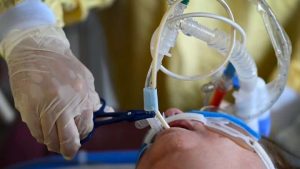Ontario requests help from Canadian Armed Forces as critical care COVID-19 cases surge

Ontario has made a formal request to the Canadian Armed Forces to help deal with a surge in critical care cases associated with COVID-19’s third wave, just days after it rebuffed an offer by the federal government to send in extra personnel.
Ontario man believed to be 1st Canadian with COVID-destroyed lungs to get double transplant
In a statement Monday, a spokesperson for Solicitor General Sylvia Jones said the province has “made a request for the assistance of those identified resources, many of whom reside, for example, within the Canadian Armed Forces and Canadian Red Cross organizations.”
“In addition to health human resources, we are requesting logistical and operational support as we seek to augment our response to COVID-19,” the statement from Jones’s press secretary Stephen Warner said.
The news comes as Ontario reported another 3,510 cases of COVID-19 on Monday, while the number of patients with the illness who need a ventilator to breathe topped 600.
According to the Ministry of Health, 877 people with COVID-19 are being treated in intensive care units across the province, twice as many as there were at the beginning of April.
Critical Care Services Ontario, a government agency that compiles daily a report for hospitals and health organizations, said that 59 patients were admitted to ICUs yesterday alone. Anthony Dale, president of the Ontario Hospital Association, said that a total of 1,415 COVID patients have been sent to ICUs this month so far.
Of those in intensive care, 605 patients are on a ventilator — nearly double the number seen at the peak of the second wave in January.
Public health units also recorded the deaths of 24 more people with the disease, pushing the official toll to 7,935. The seven-day average of deaths has climbed to a third-wave high of 28.6.
Among those Ontarians who recently died with COVID is a 13-year-old girl from Brampton.
In a statement, Premier Doug Ford called Emily Victoria Viegas’ death a “devastating reminder of what this virus can do.
“I’m sending my deepest condolences to everyone who is suffering from the terrible loss of this young life,” he said. Ford remains in isolation after being exposed to a staffer who tested positive for COVID-19.
Meanwhile, Dr. Dirk Huyer, Ontario’s chief coroner, noted in an interview with CBC News Network that 27 people with COVID — many of them under the age of 60 — have died suddenly at home throughout April.
The new cases in today’s update include:
- 1,015 in Toronto
- 909 in Peel Region
- 391 in York Region
- 244 in Durham Region
- 206 in Ottawa
- 143 in Halton Region
Notably, labs completed just 33,822 tests for SARS-CoV-2, the virus that causes COVID, the fewest in more than a month. They reported a provincewide positivity rate of 10.9 per cent, a new high for Ontario, though it is not unexpected given the relatively low testing level.
The seven-day average of daily cases dropped to 3,917, the first time it has fallen below the 4,000 mark in nearly two weeks. The measure has been slowly but steadily declining since April 17.
Another 4,057 cases were marked resolved in today’s provincial report. There are about 40,586 confirmed, active infections in Ontario.
Dr. David Williams, Ontario’s chief medical officer of health, said last week that it appeared cases were plateauing and indeed that seems to be the case. The current stay-at-home order was implemented on April 8, about two and a half weeks ago, and the slowing growth in new cases may indicate the restrictions are having an effect.
Several vaccine shipments expected this week
Sunday’s low testing number was accompanied by a considerable drop in vaccinations.
Public health units collectively administered just 69,308 doses of COVID-19 vaccines, the Ministry of Health said — far below the minimum target of at least 100,000 per day and less than half of Ontario’s 150,000 per day capacity.
Ontario has used 4,696,211, or about 89 per cent, of the 5,248,345 doses it has received to date. Slightly less than 30 per cent of the province’s total population has had at least one dose of a vaccine.
Health officials are expecting several significant shipments this week: 396,630 doses of the Pfizer vaccine and 116,700 doses of the single-shot Johnson & Johnson vaccine. A delivery of 389,000 AstraZeneca doses that were scheduled to land last week has still not arrived, and it is unclear when it will.
The CEO of the Ontario Pharmacists Association (OPA) told CBC News he anticipates the some 1,400 pharmacies administering the AstraZeneca vaccine to run out of doses within seven to 10 days.
Justin Bates said there will likely be a lull in the availability of vaccines through participating pharmacies as doses dwindle. The OPA is discussing a potential pilot project with the health ministry that would see some pharmacies offer Pfizer and Moderna vaccines.
Select locations in designated hot spots could begin offering the vaccines as early as this week, Bates said.
“It will allow us to get all the distribution and logistics down and then have a broader roll out,” he said.
Late last week, Ontario’s COVID-19 science advisory table recommended that the province revise its vaccine rollout plan to divert up to 50 per cent of available vaccine doses to 74 hot spot postal codes. The current strategy allows for 25 per cent of total doses to go to 114 designated hot spots.
In a brief posted online, the science table said that the shift in approach would also speed vaccines to essential workers, and could potentially prevent up to 20 per cent of forecasted infections among those aged 16 to 59 years old.
Asked about the recommendation during question period at the legislature, Health Minister Christine Elliott gave no indication that the government is currently considering making the change. But speaking to reporters afterward, Elliot said she takes the recommendation seriously and that a decision will be made soon.
That said, the rollout strategy also offers significant autonomy to public health units to make internal decisions about the distribution of vaccines even without a formal change in the province’s broader plan.








Redes Sociais - Comentários